Guide to Choosing the Best Commercial Roofing for Your Business
August , 2025 | 8 min. read
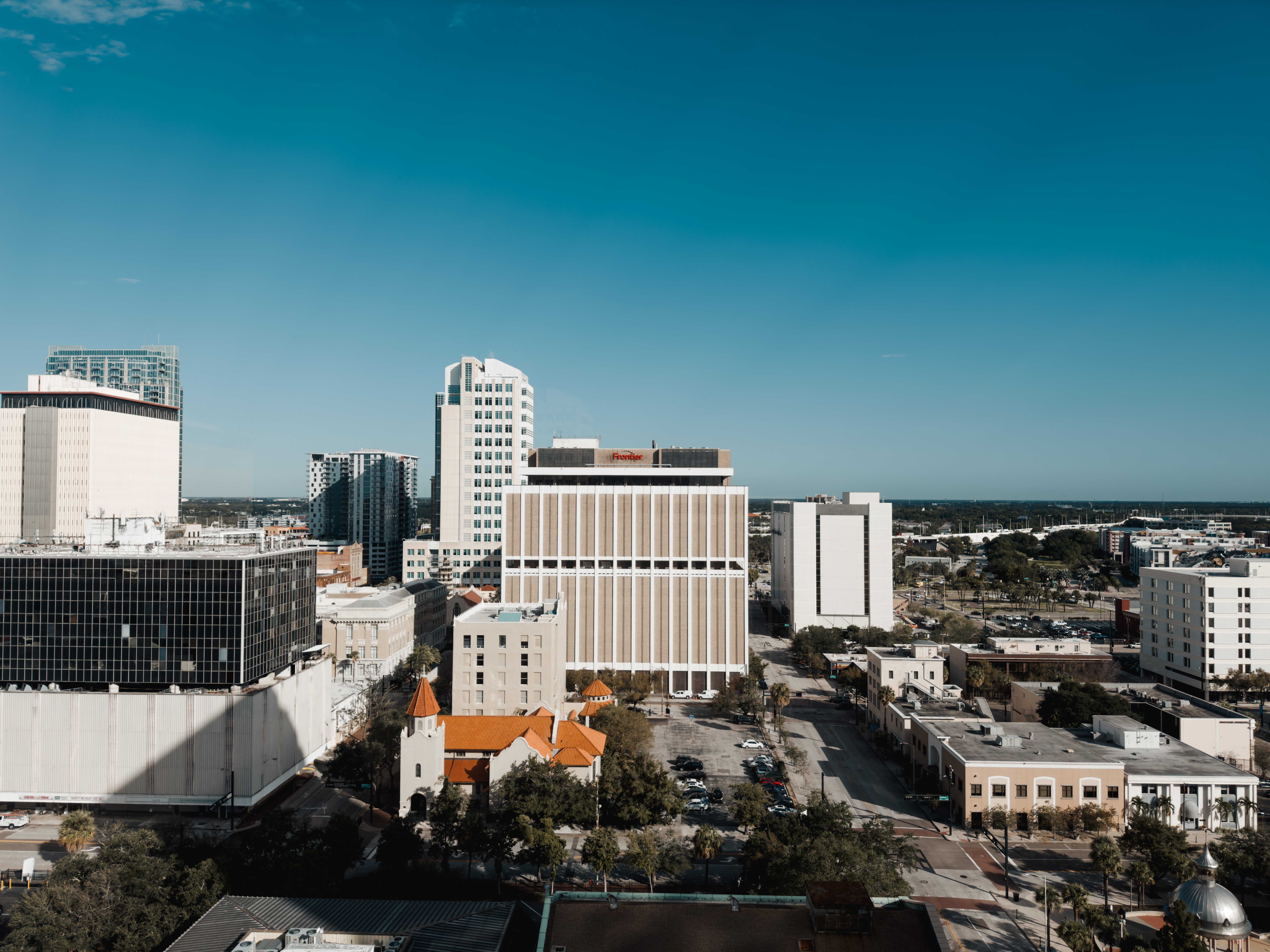
Have you ever seen a building with a stunningly bright white roof? If so, you probably came across TPO. This roofing material is one of the most commonly used today, but even though it's popular, most business owners can't tell you exactly what it is. What about EPDM? Or even modified bitumen? To some, these names may ring a dull bell when mentioned by a roofing contractor, but many have never heard of or know anything about them
If you're in the same boat, you've come to the right place. Here at RoofCrafters, we've been providing commercial roofing services for 30 years, helping business professionals understand their options before ultimately deciding which type of roof they want.
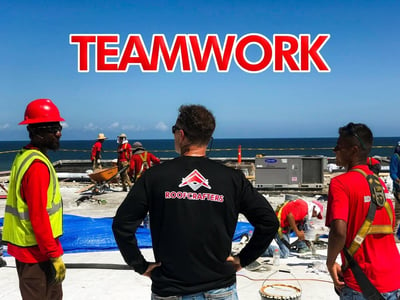
Because we've been installing roofs for three decades, we know what works and looks best for each project, and our clients agree! So trust us when we say, we get it. Everyone wants to choose the finest materials for their commercial business, and I'm sure you're no different.
Who doesn’t want to work or live in a building that feels sturdy, safe, and comfortable? There are so many possibilities to choose from, and it's easy to lose sight of what's essential. When facing a huge decision like selecting a new roofing material, you must ensure you're aware of your options. Even though there are numerous roofing choices out there, today we'll dive deep into the most popular commercial roofing materials, along with their definitions and uses. So, let’s get started!
Navigating Commercial Roofing Choices
There are several different types of commercial roofing materials on the market. Yet, not all commercial roofing options are the same. Having roof industry insights can help you decide which is right for your project.
What Are The Top Commercial Roofing Materials?
The most popular materials include:
- Thermoplastic Polyolefin (TPO): TPO roofing membranes are known for their energy efficiency, durability, and flexibility. They offer resistance to UV radiation, ozone, and chemicals.
- Polyvinyl Chloride (PVC): PVC is a synthetic plastic polymer commonly used in various applications, including roofing. PVC roofing membranes are made by blending PVC with other additives and reinforcing materials.
- Ethylene Propylene Diene Monomer (EPDM): EPDM is a synthetic rubber roofing material. It is highly durable, weather-resistant, and cost-effective. EPDM roofs are typically black and can help with energy efficiency.
- Metal Roofing: Metal roofs, such as steel, aluminum, or copper, are known for their longevity, durability, and resistance to fire and extreme weather conditions. They can be a cost-effective option in the long term due to their low maintenance requirements.
- Modified Bitumen: This is a type of asphalt-based roofing material that combines the advantages of built-up roofing and modern technology. Modified bitumen offers enhanced durability, flexibility, and ease of installation.
Leading Commercial Roofing Materials
TPO Roofing
TPO is an acronym for thermoplastic polyolefin (see why the roofing industry shortened that?) and is a single-ply membrane that’s used most commonly in commercial roofing, however, there are instances where residential roofing will use it, too.

When creating the membrane, a hot air welder is used to heat it, turning it into plastic and making it moldable. A roller is then used to fuse the top and bottom membranes, forming a "watertight" seam.
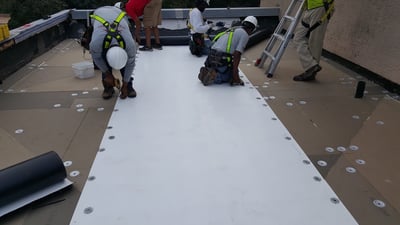
TPO membranes can either be mechanically attached or fully adhered. Mechanically attached membranes are cheaper, while fully adhered membranes are more expensive. TPO is white, so it does a great job of reflecting heat as opposed to absorbing it. This will keep your flat roof and commercial area cool in temperature. TPO will remind you of how important regular maintenance is, though, because as you know, white roofs become dirtier a lot quicker than other colors.
EPDM Roofing
EPDM roofing, also known as Ethylene Propylene Diene Monomer roofing, is a popular choice for commercial buildings. It is a synthetic rubber membrane that provides a durable and weather-resistant solution for flat or low-slope roofs. EPDM roofing membranes are typically black and are available in large sheets that are either mechanically fastened, fully adhered, or ballasted onto the roof surface.
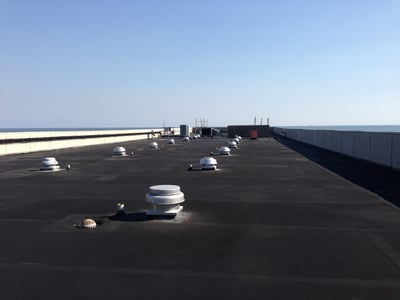
These sheets are made from a combination of ethylene, propylene, and a small amount of diene monomer, which gives the material its excellent resistance to weathering, UV radiation, and ozone. One of the key advantages of EPDM roofing is its durability. It has a long lifespan, often ranging from 25 to 30 years or more, making it a cost-effective choice in the long run. The material can withstand extreme temperatures, from intense heat to cold, without significant degradation.
Metal Roofing
Metal roofs have gained popularity in commercial applications. This is due to their durability, longevity, and aesthetic appeal. Typically made of steel, aluminum, or galvalume, commercial metal roofs offer several advantages over other roofing materials.

One of the primary benefits of commercial metal roofing is its exceptional durability. Metal roofs can withstand extreme weather conditions, including high winds, heavy rain, snow, and hail.
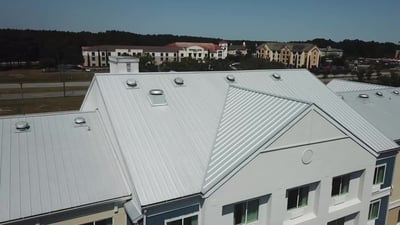
They are resistant to fire and can effectively shed snow and ice, preventing excessive weight buildup on the roof. Longevity is another key advantage of metal roofing. When properly installed and maintained, metal roofs can last 70+ years. This durability makes them a cost-effective option in the long term, as they require minimal repairs and replacement compared to other roofing materials.
Modified Bitumen Roofing
Modified Bitumen, or Modbit, is a primarily commercial roofing material that’s been used for nearly 50 years now. It’s made up of a membrane that consists of several layers of bitumen (asphalt), fiberglass, and rubber-based polymeric binders. These layers then get fused to create the final product, which is a single-ply system that's easy to install and durable against natural forces.
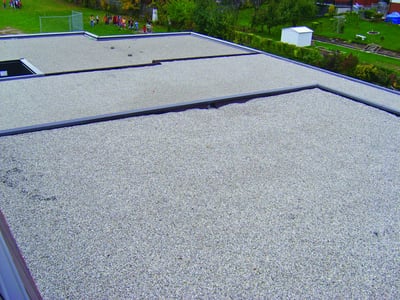
So, what does it look like? Modbit usually comes in sections 3 feet long, which makes rolling them out on the roof and heating with a torch for adherence a breeze for roofing professionals.
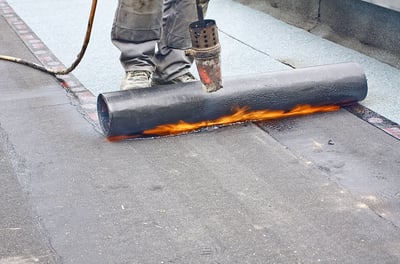
Fun fact: if you’ve ever heard of “torch down roofing”, that’s where this term derives from. Of course, there are other ways to adhere Modbit to the substrate, but torch heating is the most commonly used method. With Modbit, the seams must be watertight during the installation process. As the contractor works their magic, they’ll finish the process off with either a granular surface or a smooth surface to protect your building from harmful UV rays.
Choosing the Right Roofing Material for Your Business Needs
As a business owner, you’re well aware of the fact that selecting the right roofing material for your building is important. Several factors play a key role, including your specific needs, budget, climate, and aesthetic preferences.
Each roofing material has its own set of advantages and considerations to take into account. If you prioritize energy efficiency, durability, and low maintenance, TPO, PVC, or EPDM are all great options for large commercial projects.
TPO offers excellent resistance to UV radiation. PVC is chemical-resistant, which is great for restaurants. EPDM is known for its durability and weather resistance. For longevity and resistance to fire and extreme weather conditions, metal roofing, such as steel, aluminum, or galvalume, is a top choice. Metal roofs are also low-maintenance and can be cost-effective in the long run.
That being said, if all of these acronyms have gone over your head, don't worry! RoofCrafters is here to help provide you with expert commercial roofing advice. Simply hit the “schedule an inspection” button down below, and one of our friendly representatives will schedule your appointment with a certified roofing expert at your earliest convenience to discuss commercial roofing material comparisons, comments, and concerns.
My name is Cassie, and I’m the Content Manager here at RoofCrafters. I was born and raised in Chicago, Illinois, and made my way out to Florida post-college graduation. I’m incredibly passionate about writing and creating valuable content that helps others with the collaboration of my marketing team. When I’m not working, I enjoy shopping (a little too much), spending time at the beach, and reading!



